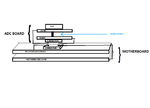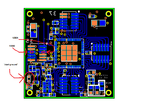SamV
Newbie level 6

- Joined
- Apr 5, 2014
- Messages
- 12
- Helped
- 0
- Reputation
- 0
- Reaction score
- 0
- Trophy points
- 1
- Activity points
- 141
Hi All,
I have an ADC layout I've been testing. The ADC board itself is a 1" square. On the ADC board I've used a star ground topology.
The ADC board connects to a motherboard with AGND and DGND between the ADC board and motherboard.
My concern is that I have the star ground on the ADC board and not the motherboard.
Is this okay? Should the star ground point be on the motherboard instead of the ADC board?
let me know if you would like any more details
Any help is appreciated
Thanks
Sam
I have an ADC layout I've been testing. The ADC board itself is a 1" square. On the ADC board I've used a star ground topology.
The ADC board connects to a motherboard with AGND and DGND between the ADC board and motherboard.
My concern is that I have the star ground on the ADC board and not the motherboard.
Is this okay? Should the star ground point be on the motherboard instead of the ADC board?
let me know if you would like any more details
Any help is appreciated
Thanks
Sam



